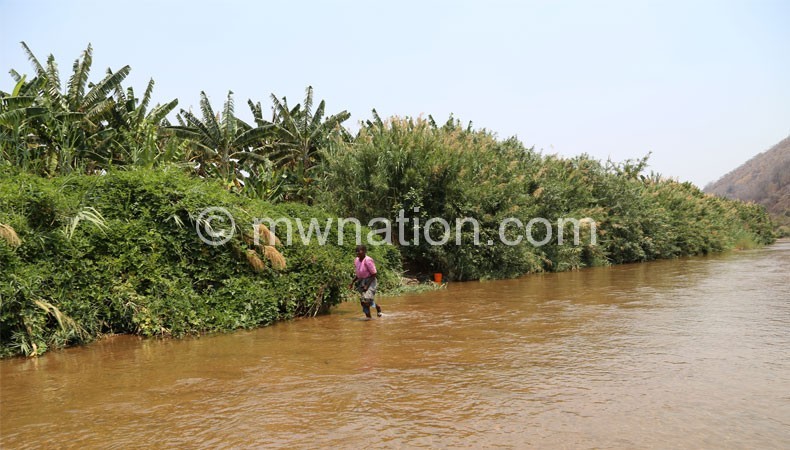Karonga’s green dykes bearing fruit

With the rains almost here again, how are flood-prone communities in Karonga lessening the likelihood of floods? JAMES CHAVULA writes.
By North Rukuru River, Mwamasapa villager Diverse Ngwira nurtures his orchard remembering how the villagers once fled their homes due to devastating floods.
“How can we heed government’s calls for us to relocate upland when we are surrounded by barren hills and this is the only fertile land we have?” asks the farmer of fruits, gazing at hilltops of Ching’ando, Vilaule and Mukoma in the neighbourhood.
For years, the father of five and his two wives have viewed the Lake Malawi inlet, which flows from Nthalire Hills in Chitipa Wenya, as the village’s major curse.
By contrast, some rice growers in the northern part of the district call it a blessing because its menacing spills nourish their fields with water and fertile alluvial soils.
From his viewpoint, he says: “Heavy rains always bring a nagging fear that Rukuru will flood again and sweep away our houses, crops, livestock and many other valuables down to the lake.”
This is no fear of the unknown. He was a boy in 1987 when the river with no defined course swelled monstrously.
“That was probably the worst disaster the village has seen,” he says. “Apart from uprooting maize and cassava from the fields, it went away with chickens, goats and cattle.”
Not that it was the first and last flood. The latest spate occurred in April this year—except that they have become mild and less destructive as people are aware of the disaster hence they take steps to lessen its impact on their lives.
Welcome to the village located some 100 metres away from the river which many communities downstream love to hate.
Beside the household of octogenarian Stephano Wayengile and his wife Otalene Ngomba is a giant mango tree with its roots exposed and battered. According to the gogos, the tree has become monumental since it reminds them how the river crossed its borders, releasing spurts of water which left behind a lake of some sort.
“A mango tree stands strong in the face of floods and storms. When you see it give in, you know it was a matter of life or death,” says Wayengile pointing to the giant tree.
Standing in the shadow of this exposed tree, the villagers recounted how they are restoring green cover in riverbanks which were left almost bare due to the tendency of growing perennial crops and feeding animals too close to the river.
From the shade, a man-made forest of bananas and other fruit trees are thickening on the river bank just where a band of reeds and creepers end.
Looking back, Ngwira explained: “It all started when chiefs, senstised by the Catholic Development Commission [Cadecom], called us together to confront our problems. During our discussions, we realised that we were suffering because of overgrazing and a tendency to cultivate right into the river. The reeds were cut and nearly no tree was left on its banks.”
Now, the man is one of 20 locals who benefited from a reforestation which is turning the one-time naked riverbanks—a highway for overflowing gushes looking for a highway to continent’s third-largest lake—into a green dyke.
Apart from bananas, Ngwira’s section of the lengthening plantation also boasts trees of guavas, oranges and masuku.
“Some people were reluctant to take part in replanting the reeds because they did not see the immediate benefit. As a result, Cadecom gave us seedlings so that we can plant fruits to safeguard the riverbanks while enhancing family income and food supply,” he says.
Every market day on Sunday, Ngomba crosses the river to the neighbouring Muchifyeghe Village. Like many, she carries a basketful of bananas and returns with cash, soap, salt, clothes and other basic needs.
”Apart from utilising market days, we sell the bananas to meat vendors from Karonga Boma,” says the granny.
Some say they earn up to K20 000 per month. One of them, Ngwira, says the bananas have become a profitable business because they are almost a staple like rice and maize.
“Thanks to bananas, I am able to send my two children, including Clever who is in Form Three at Makelele Private School in Chitipa where he pays K50 000 a term,” he says.
Similarly, Wayengile, who chairs the village’s civil protection committee, confesses buying a cow with proceeds from banana-growing and winter-cropping. During dry season, he grows maize on his field which he sells green because it is more profitable than waiting for the cobs to dry.
Says the man: “We have learnt winter cropping using treadle pumps to lift water beyond the river banks. We don’t want irrigation to threaten the protected zone.
“That’s why we have come up with by-laws which stipulate a K10 000 fine for those who feed animals, cut trees or farm within 30 metres from the river.”
This is a sign that the community is aware of disaster risk reduction and they are willing to protect themselves, says Karonga Diocese Cadecom desk officer Franklin Msiska.
“Since 2011, Cadecom, with funding from Cord-Aid, has been facilitating a process where communities are aware of hazards and impacts of disasters. We are happy seeing locals assuming leading roles in making this work,” says Msiska.






Good for them, good for the country. Good read! Well done Chabvula! Keep similar posts coming.